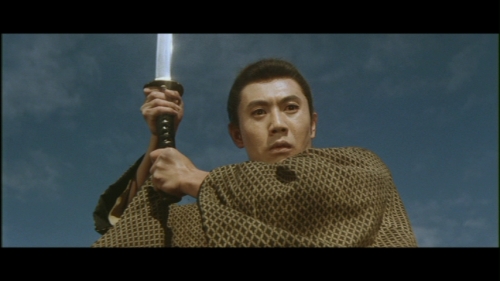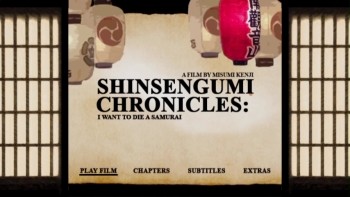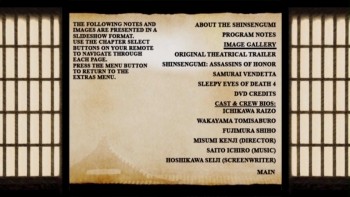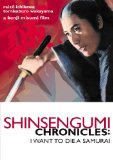| Reviews & Columns |
|
Reviews DVD TV on DVD Blu-ray 4K UHD International DVDs In Theaters Reviews by Studio Video Games Features Collector Series DVDs Easter Egg Database Interviews DVD Talk Radio Feature Articles Columns Anime Talk DVD Savant Horror DVDs The M.O.D. Squad Art House HD Talk Silent DVD
|
DVD Talk Forum |
|
|
| Resources |
|
DVD Price Search Customer Service #'s RCE Info Links |
|
Columns
|
|
|
Shinsengumi Chronicles: I Want to Die a Samurai
AnimEigo // Unrated // November 9, 2010
List Price: $24.98 [Buy now and save at Amazon]
The Film:

You don't stumble onto many more loaded titles than that of I Want To Die a Samurai, the subtext underneath the more prominently-featured Shinsengumi Chronicles. Those six words tell a story in themselves; they affirm one's willingness to die for the code of honor that a samurai upholds, while also suggesting a hit of idealism in its tone. These elements surround the fabric of Lone Wolf and Cub and Zatoichi director Misumi Kenji's early film about the Shinsengumi during the mid-'1800s, a division of Shogunate supporter samurai in Kyoto. A real-life account of the tumultuous time in the faction's midst leads into what's considered one of the more apt portrayals of the Ikedaya Incident, an event where the Shinsengumi defend against anti-Shogunate rebels looking to burn the city and kidnap the emperor. Misumi Kenji's direction is assured and often captivating as he portrays the volatile happenings, even if the Daiei Studios' production offers more a collection of moments and a chronicle of the impactful event than a comprehensive film.
Patrick Galloway, author of "Stray Dogs and Lone Wolves: The Samurai Film Handbook", asserts that the film resembles that of a take on the Knights of the Roundtable, and he's not incorrect in that thought. It begins with a young samurai upstart, Yamazaki (Raizo Ichikawa, Shinobi no Mono), slipping into the infrastructure of the Shinsengumi, mostly under the pretense of admiration for the ways of the samurai. He converses with leader Kondo Isami (Wakayama Tomisaburo) about whether the death of one of the order's samurai was honorable, leading him into a network of communication with its members that arranges an infrastructure built around contrasting identities. Though still interesting as it concentrates on talking about the humble origins of its members, as well as constructing the dramatic atmosphere in their headquarters, it makes for a ploddingly-paced first half-hour, a slow-absorb of character curio.
It's only when the first call for seppuku occurs in the order against one of the leaders that the Shinsengumi Chronicles escalates its portrayal of the clash between idealism and honor, becoming a vitalizing experience. Characters that include the clan's strong-arm -- later referred to as a "creator" -- and Wakayama Tomisaburo's farmer-turned-leader blur the line between admirable leaders and in-the-moment, opportunistic pragmatists, becoming part of the film's bedrock. Amid calls for seppuku over greedy extortion, men being crucified for their anti-Shogunate actions, and quick murder cover-ups occurring in the middle of the night, Yamazaki's noble perception of this waning way of life begins to deteriorate. Raizo Ichikawa and Tomisaburo Wakayama offer two nuanced performances as the idealist as the object of his admiration respectfully, along with that of Yamazki's devout love interest Shima (Fujimura Shiho) struggling with his staunch fidelity to the maligned order.
Misumi Kenji strategically places bursts of no-nonsense katana duels and brawls in Shinsegumi Chronicles, seamlessly stitching them into the film more as dramatic extensions than acts of attention-grabbing violence. There are two exceptions; the first being a beautifully-shot duel in the midst of a dark, foggy evening, where Yamazaki squares off with a group of the rebels while shooing away his companions so that he can do the work himself. He does this as an act to prove his worth to the Shinsegumi, ironically juxtaposed against this murky setting to heighten the notion of the clouded ideals that he holds to such high regard. The other, naturally, comes in the full-on defense against the volatile rebels at the end of the picture during the actual capturing of the Ikedaya Incident, which, in its dramatic fabric around treason and honorable acts, reinforces the meaning behind the subtext "I Want To Die a Samurai".
The DVD:
Video and Audio:
Shinsengumi Chronicles: I Want to Die a Samurai arrives fron AnimEigo in a 2.35:1 anamorphic widescreen presentation that, much like the labels other presentations of classic '60s-'70s Japanese works, admirably projects the aged cinematography to deft levels. AnimEigo has done a tremendous job of rendering respectable detail, color solidity, and apropos skin tones in the dusty color schemes, and this disc doesn't differ from that. It does have limitations; contrast leans more to the murky olive-green side instead of deeper black when needed, a few speckles and blips in the print crop up, and some backdrops during faster-paced moments have a strange ghosting/blurring effect. Other than that, the overall fluidity of movement during the handful of sword duels looks very clean and film-like, while the focused close-ups offer some pleasantly surprising crispness, considering the source.
Audio comes in a Dolby 2.0 Stereo track that's not as impressive as the visual presentation, but supports the film's purposes well enough to be tolerable. Vocal delivery twangs with age-latched harshness and somewhat cramped sound effects, though they still pour through to an agreeably clear level. some hissing can be heard intermittently, along with a few pops, but the overall balance during the numerous quiet sequences can be impressive. It's in the subtitles that AnimEigo once again pulls out all the stops, offering a total of five (5) different English language options: Yellow/Green subs available with or without cultural information about cities and terms, White/Gray subs with the same two options, or generic White subtitles.
Special Features:
As per AnimEigo's other releases, the supplemental features are limited to an Image Gallery, Cast/Crew Bios, a series of in-depth and helpful Program Notes for those who know little about the events portrayed in the film (the About the Shinsengumi piece will be very helpful to read before the film), and a series of Trailers -- one for Shinsengumi Chronicles, and a few others for semi-related films.
Final Thoughts:
There are two sides to Misumi Kenji's Shinsengumi Chronicles: I Want To Die a Samurai that are compelling. As a depiction of a particular point in Japanese history, specifically around an the suppression of a rebellion in 1800s Kyoto, the political energy it taps into starts slow, but builds to an intriguing simmer within the Shinsengumi's conflict-riddled power struggle. A few bursts of down-'n-dirty swordplay find their way into the mix, though they're more extensions of the drama than attention-grabbers. As a meditation on a idealist's perception of honor amid pragmatic conflicts, it also cracks open to a vein of interesting dramatic moments -- especially when the content falls on calls for ritualistic suicide. AnimEigo's DVD and the film both come with a firm Recommendation.
Thomas Spurlin, Staff Reviewer -- DVDTalk Reviews | Personal Blog/Site

You don't stumble onto many more loaded titles than that of I Want To Die a Samurai, the subtext underneath the more prominently-featured Shinsengumi Chronicles. Those six words tell a story in themselves; they affirm one's willingness to die for the code of honor that a samurai upholds, while also suggesting a hit of idealism in its tone. These elements surround the fabric of Lone Wolf and Cub and Zatoichi director Misumi Kenji's early film about the Shinsengumi during the mid-'1800s, a division of Shogunate supporter samurai in Kyoto. A real-life account of the tumultuous time in the faction's midst leads into what's considered one of the more apt portrayals of the Ikedaya Incident, an event where the Shinsengumi defend against anti-Shogunate rebels looking to burn the city and kidnap the emperor. Misumi Kenji's direction is assured and often captivating as he portrays the volatile happenings, even if the Daiei Studios' production offers more a collection of moments and a chronicle of the impactful event than a comprehensive film.
Patrick Galloway, author of "Stray Dogs and Lone Wolves: The Samurai Film Handbook", asserts that the film resembles that of a take on the Knights of the Roundtable, and he's not incorrect in that thought. It begins with a young samurai upstart, Yamazaki (Raizo Ichikawa, Shinobi no Mono), slipping into the infrastructure of the Shinsengumi, mostly under the pretense of admiration for the ways of the samurai. He converses with leader Kondo Isami (Wakayama Tomisaburo) about whether the death of one of the order's samurai was honorable, leading him into a network of communication with its members that arranges an infrastructure built around contrasting identities. Though still interesting as it concentrates on talking about the humble origins of its members, as well as constructing the dramatic atmosphere in their headquarters, it makes for a ploddingly-paced first half-hour, a slow-absorb of character curio.
It's only when the first call for seppuku occurs in the order against one of the leaders that the Shinsengumi Chronicles escalates its portrayal of the clash between idealism and honor, becoming a vitalizing experience. Characters that include the clan's strong-arm -- later referred to as a "creator" -- and Wakayama Tomisaburo's farmer-turned-leader blur the line between admirable leaders and in-the-moment, opportunistic pragmatists, becoming part of the film's bedrock. Amid calls for seppuku over greedy extortion, men being crucified for their anti-Shogunate actions, and quick murder cover-ups occurring in the middle of the night, Yamazaki's noble perception of this waning way of life begins to deteriorate. Raizo Ichikawa and Tomisaburo Wakayama offer two nuanced performances as the idealist as the object of his admiration respectfully, along with that of Yamazki's devout love interest Shima (Fujimura Shiho) struggling with his staunch fidelity to the maligned order.
Misumi Kenji strategically places bursts of no-nonsense katana duels and brawls in Shinsegumi Chronicles, seamlessly stitching them into the film more as dramatic extensions than acts of attention-grabbing violence. There are two exceptions; the first being a beautifully-shot duel in the midst of a dark, foggy evening, where Yamazaki squares off with a group of the rebels while shooing away his companions so that he can do the work himself. He does this as an act to prove his worth to the Shinsegumi, ironically juxtaposed against this murky setting to heighten the notion of the clouded ideals that he holds to such high regard. The other, naturally, comes in the full-on defense against the volatile rebels at the end of the picture during the actual capturing of the Ikedaya Incident, which, in its dramatic fabric around treason and honorable acts, reinforces the meaning behind the subtext "I Want To Die a Samurai".
The DVD:
 |  |
Video and Audio:
Shinsengumi Chronicles: I Want to Die a Samurai arrives fron AnimEigo in a 2.35:1 anamorphic widescreen presentation that, much like the labels other presentations of classic '60s-'70s Japanese works, admirably projects the aged cinematography to deft levels. AnimEigo has done a tremendous job of rendering respectable detail, color solidity, and apropos skin tones in the dusty color schemes, and this disc doesn't differ from that. It does have limitations; contrast leans more to the murky olive-green side instead of deeper black when needed, a few speckles and blips in the print crop up, and some backdrops during faster-paced moments have a strange ghosting/blurring effect. Other than that, the overall fluidity of movement during the handful of sword duels looks very clean and film-like, while the focused close-ups offer some pleasantly surprising crispness, considering the source.
Audio comes in a Dolby 2.0 Stereo track that's not as impressive as the visual presentation, but supports the film's purposes well enough to be tolerable. Vocal delivery twangs with age-latched harshness and somewhat cramped sound effects, though they still pour through to an agreeably clear level. some hissing can be heard intermittently, along with a few pops, but the overall balance during the numerous quiet sequences can be impressive. It's in the subtitles that AnimEigo once again pulls out all the stops, offering a total of five (5) different English language options: Yellow/Green subs available with or without cultural information about cities and terms, White/Gray subs with the same two options, or generic White subtitles.
Special Features:
As per AnimEigo's other releases, the supplemental features are limited to an Image Gallery, Cast/Crew Bios, a series of in-depth and helpful Program Notes for those who know little about the events portrayed in the film (the About the Shinsengumi piece will be very helpful to read before the film), and a series of Trailers -- one for Shinsengumi Chronicles, and a few others for semi-related films.
Final Thoughts:
There are two sides to Misumi Kenji's Shinsengumi Chronicles: I Want To Die a Samurai that are compelling. As a depiction of a particular point in Japanese history, specifically around an the suppression of a rebellion in 1800s Kyoto, the political energy it taps into starts slow, but builds to an intriguing simmer within the Shinsengumi's conflict-riddled power struggle. A few bursts of down-'n-dirty swordplay find their way into the mix, though they're more extensions of the drama than attention-grabbers. As a meditation on a idealist's perception of honor amid pragmatic conflicts, it also cracks open to a vein of interesting dramatic moments -- especially when the content falls on calls for ritualistic suicide. AnimEigo's DVD and the film both come with a firm Recommendation.
|
| Popular Reviews |
| Sponsored Links |
|
|
| Sponsored Links |
|
|
| Release List | Reviews | Shop | Newsletter | Forum | DVD Giveaways | Blu-Ray | Advertise |
|
Copyright 2024 DVDTalk.com All Rights Reserved. Legal Info, Privacy Policy, Terms of Use,
Manage Preferences,
Your Privacy Choices | |||||||













